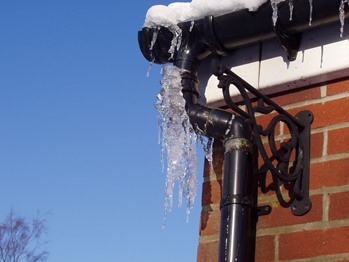How to prevent frozen pipes this winter
Josh Monen
 Water damage caused by frozen pipes are one of the most common types of claims homeowners make on their insurance, according to a report published by ISO, a Verisk Analytics company.
Water damage caused by frozen pipes are one of the most common types of claims homeowners make on their insurance, according to a report published by ISO, a Verisk Analytics company.
While “wind and hail” claims were the most common, “water damage and freezing” claims, such as frozen pipes, were No. 2 on the list — above fire, theft and dog bites.
In fact, the American Insurance Association says 22 percent of all claims on homeowners insurance policies are for winter weather damage.
We asked home safety experts about what all homeowners should know regarding frozen pipes.
1. Prepare outdoor faucets for cold weather.
Make sure to prepare your outdoor faucets for cold weather before the first freeze of the year. It’s important to do this because if a hose freezes on the outside of your home the water in the interior pipes leading to the hose can also start to freeze.
Robert Weitz, a certified microbial investigator, home safety expert and founder of RTK Environmental Group, suggests homeowners accomplish this by doing three things:
- Disconnect outdoor garden hoses.
- Keep the faucets open outside.
- Turn off the water supply valve inside usually located in the basement or on an exterior wall in a utility area of the home).
Drain the water when disconnecting your hoses, otherwise they may freeze and burst. After you disconnect each hose, locate the shutoff valve for that faucet inside. Turn the handle clockwise to turn off the water. Then, open the outside water faucet and let the water drain out. Close the valve after the water is drained.
Finally, install faucet covers. These can be purchased at hardware stores such as Home Depot for about $2 each.
2. Keep your home’s temperature at 50 degrees at least.
One of the most common reasons pipes freeze is because homeowners set their thermostats too low during the winter.
Al Ruggie, spokesman for 911 Restoration, a home-restoration company that specializes in water-damage solutions, says, “You should keep the temperature of your home at least 50 degrees to ensure you don’t allow a pipe burst.”
If you leave home for an extended period of time, set your thermostat to 50 degrees or above.
3. Insulate your water pipes.
Another way to prevent frozen pipes is to insulate them in your home’s crawlspace, basement and attic, Weitz says. Exposed pipes are most susceptible to freezing, he adds.
There are several ways to insulate pipes, including using foam pipe sleeves, installing UL-listed heat tape or using heat cables. These materials can be found at most local hardware stores.
If you’re not entirely sure what material you’ll need to complete the job then ask an employee at the hardware store for help. They should be able to tell you exactly what materials you’ll need to do the job, such as a utility knife and foam construction adhesive.
The video “How to Insulate Water Pipes to Prevent Freezing,” by Today’s Homeowner, provides more detail on how to insulate your water pipes.
4. Have an emergency plan ready if your pipe bursts.
John Kinney, chief claims officer for The Hartford, offers the following advice to homeowners, “Learn where the water shutoff is before you’re faced with a frozen pipe or water leak, and label it so anyone in your home can find it.”
When you discover a burst pipe, shut off the water immediately.
This will minimize the amount of damage the water will do to your home. After you shut off the water supply, it’s important to dry the area as quickly as possible to prevent mold growth, which can occur within 24 hours.
It’s important to remember that your insurance will only cover the immediate damage caused by the burst pipe.
So if water from the burst pipe leaks through a floor or wall and then you discover mold six months later, your insurer is unlikely to cover this.
5. Know what your homeowners or renters insurance policy covers.
If your home floods due to a burst pipe, then your homeowners or renters insurance should cover most of the damage. This type of water damage is different from a flood that enters from outside the home, which requires a separate flood policy.
Remember, if you have a deductible you’ll have to pay that first before the insurance kicks in.
“On a claim for a burst pipe, the largest costs will come from repairing or replacing the flooring or drywall,” Kinney says. “We see large costs for removing the water, which could mean drying out the affected areas or even tearing out or removing certain areas to prevent further damage.”
According to claims experts from The Hartford, frozen/burst pipes claims average about $18,000 per claim. “Other costs seen with a broken pipe can be smaller — like the plumbing itself, painting and finish/trim,” Kinney says.
It’s also important to know that water damage from frozen/burst pipes could also result in damage to your contents, like your furniture or appliances.
For example, if a pipe bursts upstairs and flooded water into your living room it could damage your rugs, furniture and appliances. Your contents would also be covered under your homeowners or renters insurance.
For more information on what your insurance policy does and doesn’t cover, contact your local insurance agent.
See how much you could save today on your home insurance. Get your free home insurance quotes today!
